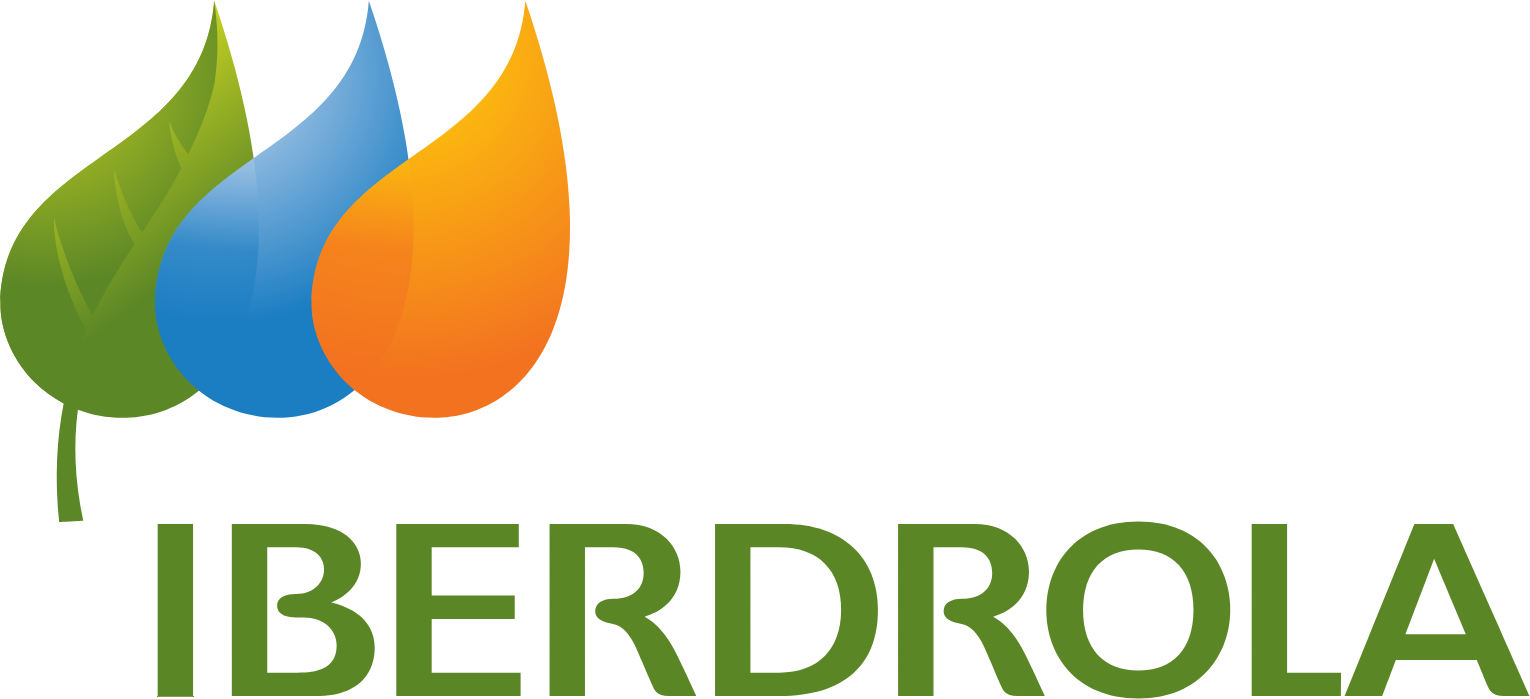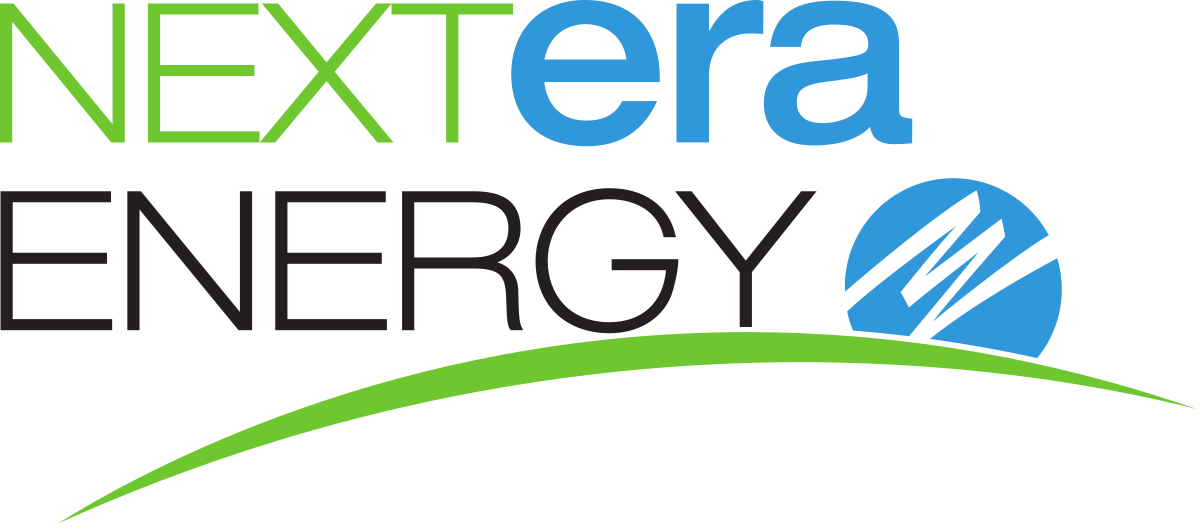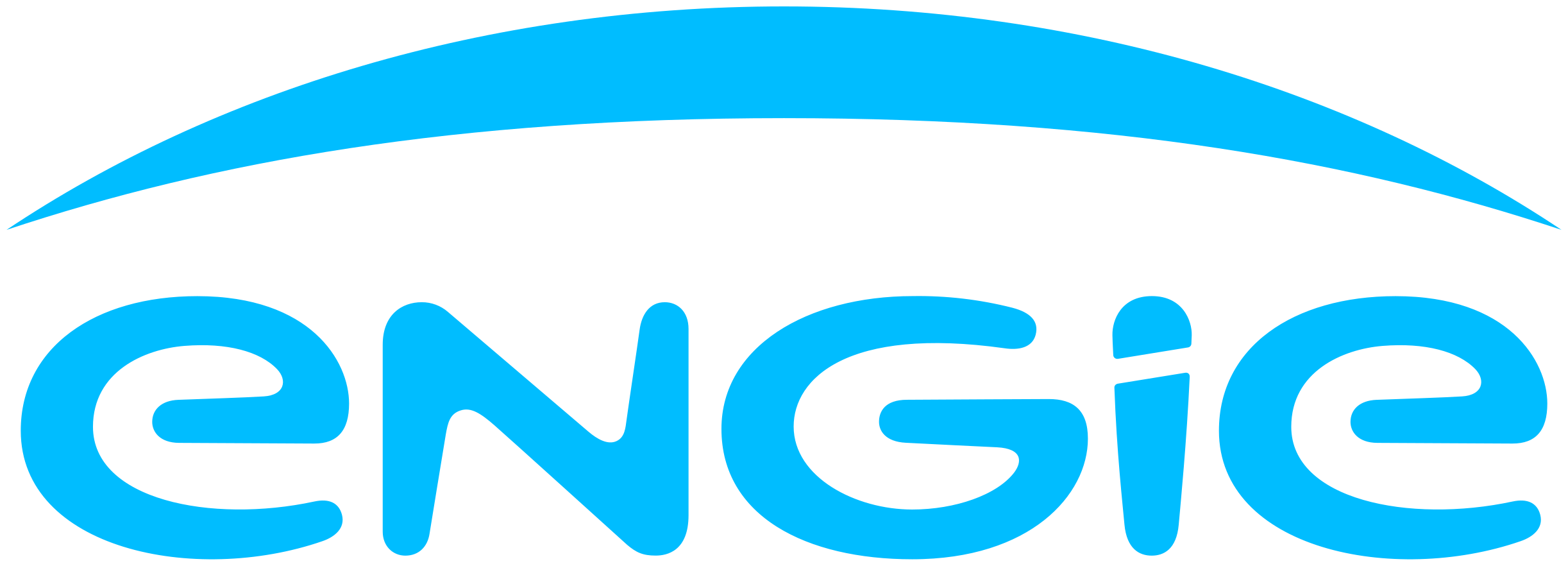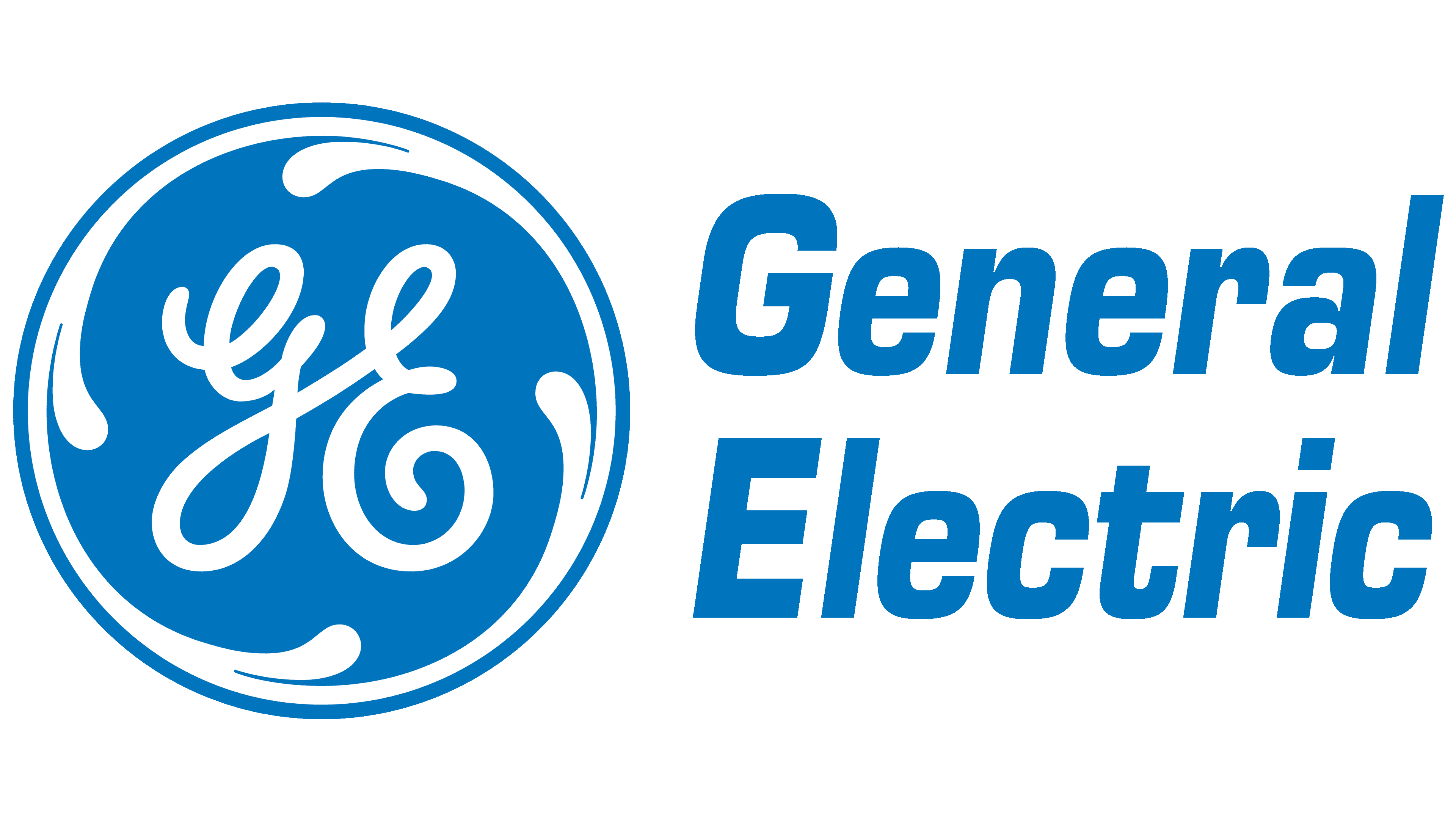Global Power Purchase Agreement Market: By Type, By Location, By Energy Type, By Tenure, By Application, By End User, By Region & Segmental Insights Trends and Forecast, 2024 – 2034
- Industry: Energy & Power
- Report ID: TNR-110-1253
- Number of Pages: 420
- Table/Charts : Yes
- August, 2024
- Base Year : 2024
- No. of Companies : 10+
- No. of Countries : 29
- Views : 10084
- Covid Impact Covered: Yes
- War Impact Covered: Yes
- Formats : PDF, Excel, PPT
Power purchase agreement market is experiencing transformative growth, driven by an increasing shift towards renewable energy sources and the need for stable, long-term energy procurement solutions. PPAs are contracts between energy buyers and sellers where the buyer agrees to purchase electricity at a predetermined price for a specified period.
Market Overview: Global Power Purchase Agreement Market
The global power purchase agreement market has seen substantial growth over recent years, primarily fuelled by the transition to renewable energy sources, government policies promoting clean energy, and the desire for price stability in energy procurement. The market features a range of PPA structures, including physical delivery PPAs, virtual PPAs, portfolio PPAs, block delivery PPAs, and other variations, each serving different needs and stakeholders in the energy sector. As of 2023, the power purchase agreement market was valued at approximately USD 21.8 Bn and is expected to grow at a compound annual growth rate (CAGR) of around 43.3% from 2024 to 2034.
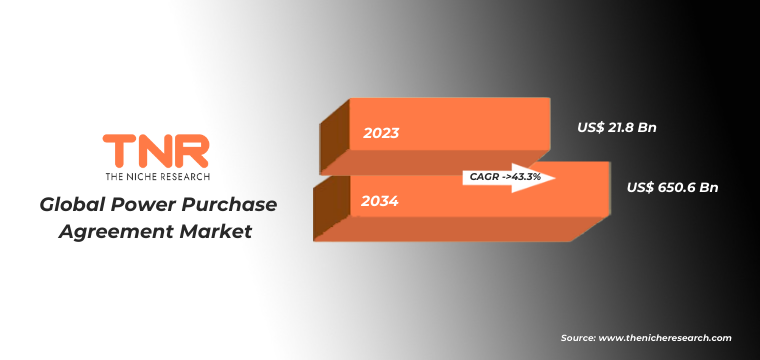
Market Trends: Global Power Purchase Agreement Market
- Corporate Adoption of Renewable Energy: A significant trend is the rising number of corporations entering into PPAs to meet their sustainability targets. For instance, major tech companies like Google and Microsoft have been at the forefront, securing large-scale PPAs to power their operations with renewable energy. In 2023, Microsoft announced a landmark PPA for 2.5 gigawatts (GW) of wind and solar power, underscoring the trend of corporations committing to long-term renewable energy contracts.
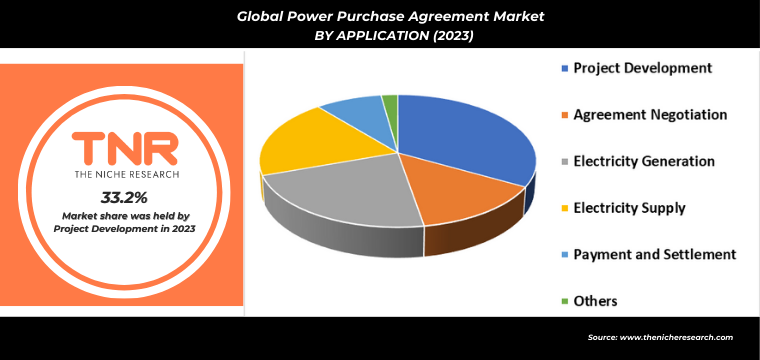
- Emergence of Hybrid Projects: Hybrid renewable energy projects combining solar, wind, and storage solutions are gaining traction. These projects offer increased reliability and flexibility, attracting more investors and buyers. A notable example is the 2023 announcement of a hybrid PPA between Amazon and Enel Green Power, which includes both solar and wind capacity along with battery storage.
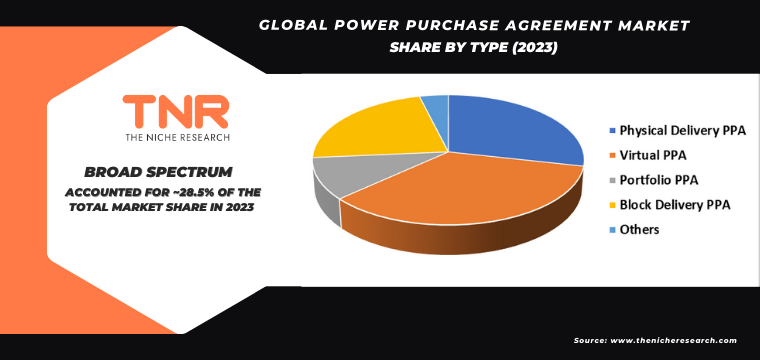
- Regulatory and Policy Support: Government policies and incentives continue to play a crucial role in shaping the power purchase agreement market. In the European Union, the Renewable Energy Directive and national support schemes have facilitated the growth of PPAs. The European Union’s goal of a 55% reduction in greenhouse gas emissions by 2030 has led to a surge in Power Purchase Agreements (PPAs) throughout its member states.

Growth in Solar and Wind PPAs: Global Power Purchase Agreement Market
The growth in solar and wind power purchase agreements highlights a major shift towards renewable energy, fuelled by technological advancements and cost reductions. In 2023, solar energy represented around 60% of all PPA deals, a testament to the significant drop in solar photovoltaic (PV) costs, which have decreased by over 80% in the past decade. This trend is exemplified by large-scale projects such as Google’s 2023 PPA with Ørsted for 2 GW of offshore wind power in the North Sea. Similarly, wind energy is expanding rapidly, with offshore wind projects becoming increasingly common due to their high energy output and minimal land use impact. As corporations and governments strive to meet sustainability targets, the demand for solar and wind PPAs is expected to continue growing, driving further innovation and investment in the renewable energy sector.
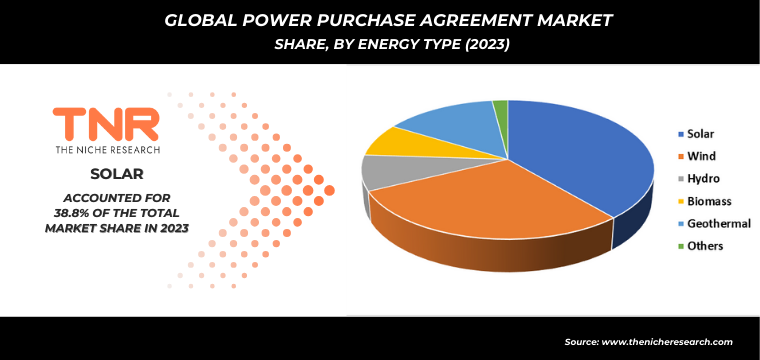
Commercial Sector is Poised to Dominate: Global Power Purchase Agreement Market
As of 2024, commercial entities account for approximately 60% of the global power purchase agreement market, underscoring their pivotal role in the sector. Companies are increasingly entering into PPAs to meet ambitious renewable energy targets and hedge against volatile energy prices. For instance, major corporations like Google and Microsoft have secured substantial PPAs to power their data centers and operations with renewable energy, highlighting the trend of large-scale commercial adoption. Google’s recent agreement to purchase 1.6 terawatt-hours (TWh) of renewable energy through PPAs exemplifies this shift, as the company aims to achieve its goal of operating entirely on renewable energy by 2030. Similarly, Microsoft has committed to sourcing 100% of its energy from renewables by 2025, with a significant portion covered through PPAs. The increasing prevalence of such agreements among commercial enterprises is fueled by their need for predictable energy costs and the growing importance of sustainability in their corporate strategies. As more businesses prioritize environmental responsibility and seek long-term energy solutions, the commercial segment’s dominance in the power purchase agreement market is set to continue, driving further growth and innovation in this sector.
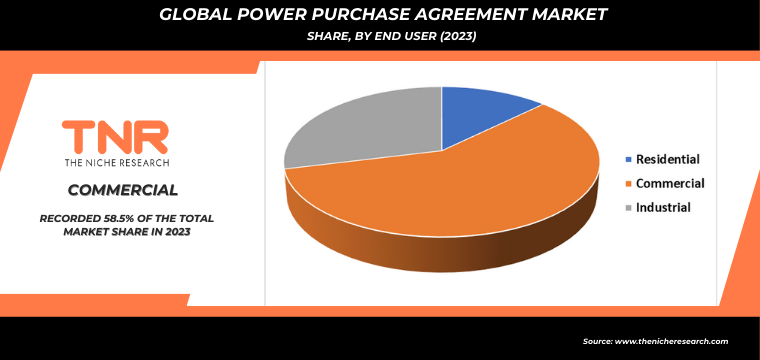
Regional Insights: Global Power Purchase Agreement Market
In 2023, the North American market dominated the global power purchase agreement market landscape, contributing over 40% of the total market value. The United States is a key player, with states like Texas and California at the forefront of PPA activity. Texas, known for its vast land and strong wind resources, has become a major hub for wind PPAs, while California’s progressive renewable energy policies have driven numerous solar agreements, such as Apple’s 600 MW solar PPA with First Solar.
Meanwhile, the Asia-Pacific region is rapidly emerging as a significant region in the power purchase agreement market. India and Australia, in particular, are expanding their PPA portfolios, spurred by supportive government policies and increasing corporate demand for renewable energy. In 2023, India saw a marked increase in corporate PPAs, exemplified by Walmart’s substantial agreement with Tata Power, reflecting a broader trend of multinational companies seeking long-term, sustainable energy solutions in the region.
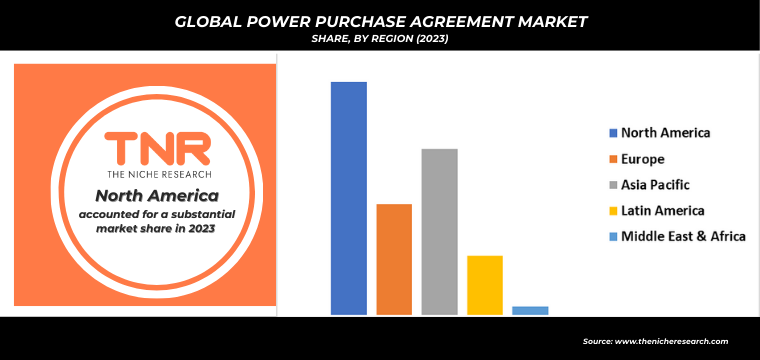
Competitive Insights: Global Power Purchase Agreement Market
- Ameresco
- Ecohz
- Enel Global Trading S.p.A.
- ENGIE
- General Electric
- NextEra Energy, Inc
- RWE
- Schneider Electric
- Shell
- Siemens
- Statkraft
- Other Market Participants
Global Power Purchase Agreement Market Scope:
| Report Specifications | Details |
| Market Revenue in 2023 | US$ 21.8 Bn |
| Market Size Forecast by 2034 | US$ 650.6 Bn |
| Growth Rate (CAGR) | 43.3% |
| Historic Data | 2016 – 2022 |
| Base Year for Estimation | 2023 |
| Forecast Period | 2024 – 2034 |
| Report Inclusions | Market Size & Estimates, Market Dynamics, Competitive Scenario, Trends, Growth Factors, Market Determinants, Key Investment Segmentation, Product/Service/Solutions Benchmarking |
| Segments Covered | By Type, By Location, By Energy Type, By Tenure, By Application, By End User, By Region |
| Regions Covered | North America, Europe, Asia Pacific, Middle East & Africa, Latin America |
| Countries Covered | U.S., Canada, Mexico, Rest of North America, France, The UK, Spain, Germany, Italy, Nordic Countries (Denmark, Finland, Iceland, Sweden, Norway), Benelux Union (Belgium, The Netherlands, Luxembourg), Rest of Europe, China, Japan, India, New Zealand, Australia, South Korea, Southeast Asia (Indonesia, Thailand, Malaysia, Singapore, Rest of Southeast Asia), Rest of Asia Pacific, Saudi Arabia, UAE, Egypt, Kuwait, South Africa, Rest of Middle East & Africa, Brazil, Argentina, Rest of Latin America |
| Key Players | Ameresco, Ecohz, Enel Global Trading S.p.A., ENGIE, General Electric, Next Kraftwerke, RWE, Schneider Electric, Shell, Siemens, Statkraft |
| Customization Scope | Customization allows for the inclusion/modification of content pertaining to geographical regions, countries, and specific market segments. |
| Pricing & Procurement Options | Explore purchase options tailored to your specific research requirements |
| Contact Details | Consult With Our Expert
Japan (Toll-Free): +81 663-386-8111 South Korea (Toll-Free): +82-808- 703-126 Saudi Arabia (Toll-Free): +966 800-850-1643 United Kingdom: +44 753-710-5080 United States: +1 302-232-5106 E-mail: askanexpert@thenicheresearch.com
|
Global Power Purchase Agreement Market
By Type
- Physical Delivery PPA
- Virtual PPA
- Portfolio PPA
- Block Delivery PPA
- Others
By Location
- On Site
- Off Site
By Energy Type
- Solar
- Wind
- Hydro
- Biomass
- Geothermal
- Others
By Tenure
- Short term
- Medium Term
- Long term
By Application
- Project Development
- Agreement Negotiation
- Electricity Generation
- Electricity Supply
- Payment and Settlement
- Others
By End User
- Residential
- Commercial
- Industrial
By Region
- North America (U.S., Canada, Mexico, Rest of North America)
- Europe (France, The UK, Spain, Germany, Italy, Nordic Countries (Denmark, Finland, Iceland, Sweden, Norway), Benelux Union (Belgium, The Netherlands, Luxembourg), Rest of Europe)
- Asia Pacific (China, Japan, India, New Zealand, Australia, South Korea, Southeast Asia (Indonesia, Thailand, Malaysia, Singapore, Rest of Southeast Asia), Rest of Asia Pacific)
- Middle East & Africa (Saudi Arabia, UAE, Egypt, Kuwait, South Africa, Rest of Middle East & Africa)
- Latin America (Brazil, Argentina, Rest of Latin America)
Report Layout:
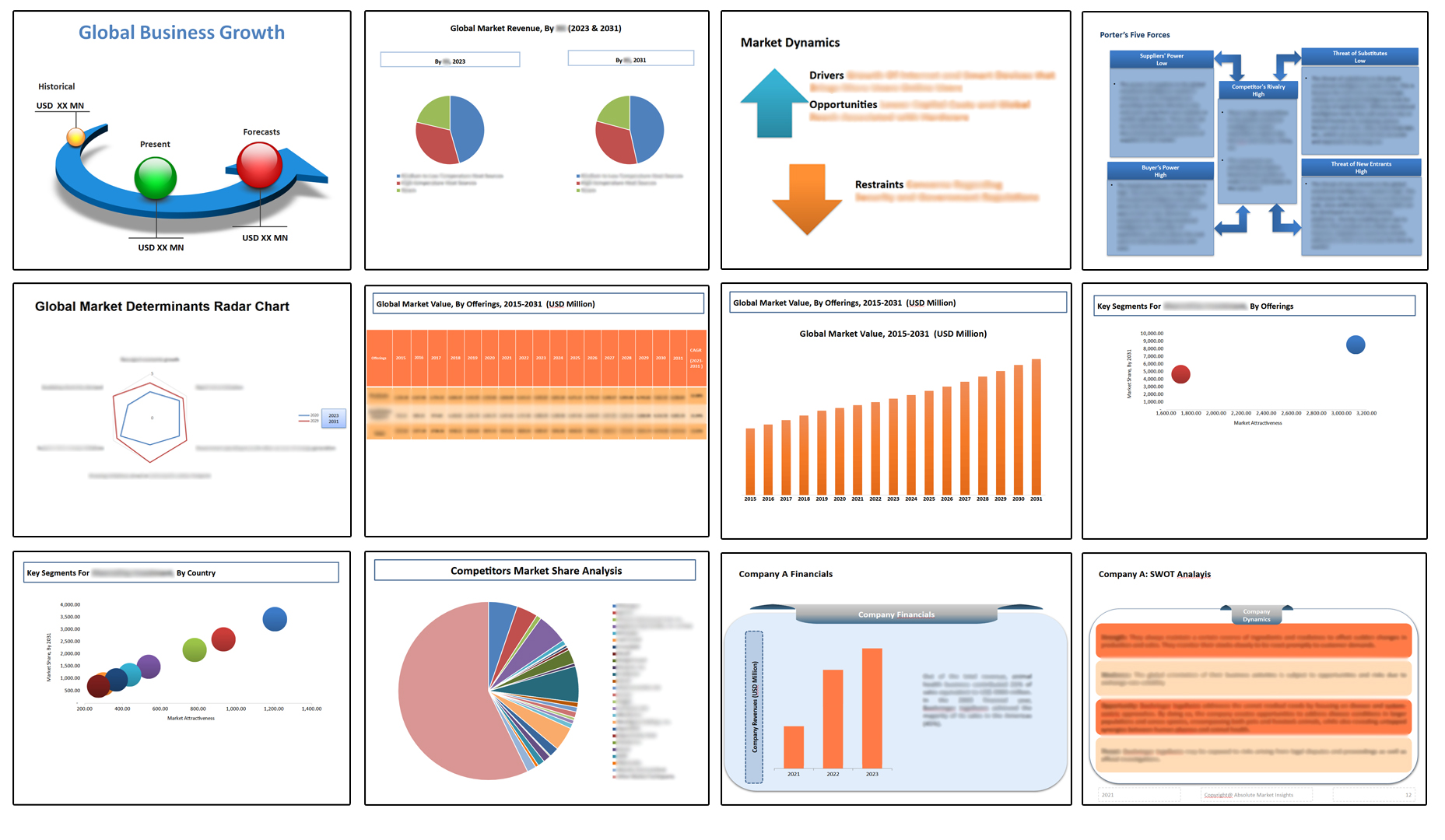
Table of Contents
Note: This ToC is tentative and can be changed according to the research study conducted during the course of report completion.
**Exclusive for Multi-User and Enterprise User.
Global Power Purchase Agreement Market
By Type
- Physical Delivery PPA
- Virtual PPA
- Portfolio PPA
- Block Delivery PPA
- Others
By Location
- On Site
- Off Site
By Energy Type
- Solar
- Wind
- Hydro
- Biomass
- Geothermal
- Others
By Tenure
- Short term
- Medium Term
- Long term
By Application
- Project Development
- Agreement Negotiation
- Electricity Generation
- Electricity Supply
- Payment and Settlement
- Others
By End User
- Residential
- Commercial
- Industrial
By Region
- North America (U.S., Canada, Mexico, Rest of North America)
- Europe (France, The UK, Spain, Germany, Italy, Nordic Countries (Denmark, Finland, Iceland, Sweden, Norway), Benelux Union (Belgium, The Netherlands, Luxembourg), Rest of Europe)
- Asia Pacific (China, Japan, India, New Zealand, Australia, South Korea, Southeast Asia (Indonesia, Thailand, Malaysia, Singapore, Rest of Southeast Asia), Rest of Asia Pacific)
- Middle East & Africa (Saudi Arabia, UAE, Egypt, Kuwait, South Africa, Rest of Middle East & Africa)
- Latin America (Brazil, Argentina, Rest of Latin America)
The Niche Research approach encompasses both primary and secondary research methods to provide comprehensive insights. While primary research is the cornerstone of our studies, we also incorporate secondary research sources such as company annual reports, premium industry databases, press releases, industry journals, and white papers.
Within our primary research, we actively engage with various industry stakeholders, conducting paid interviews and surveys. Our meticulous analysis extends to every market participant in major countries, allowing us to thoroughly examine their portfolios, calculate market shares, and segment revenues.
Our data collection primarily focuses on individual countries within our research scope, enabling us to estimate regional market sizes. Typically, we employ a bottom-up approach, meticulously tracking trends in different countries. We analyze growth drivers, constraints, technological innovations, and opportunities for each country, ultimately arriving at regional figures.Our process begins by examining the growth prospects of each country. Building upon these insights, we project growth and trends for the entire region. Finally, we utilize our proprietary model to refine estimations and forecasts.
Our data validation standards are integral to ensuring the reliability and accuracy of our research findings. Here’s a breakdown of our data validation processes and the stakeholders we engage with during our primary research:
- Supply Side Analysis: We initiate a supply side analysis by directly contacting market participants, through telephonic interviews and questionnaires containing both open-ended and close-ended questions. We gather information on their portfolios, segment revenues, developments, and growth strategies.
- Demand Side Analysis: To gain insights into adoption trends and consumer preferences, we reach out to target customers and users (non-vendors). This information forms a vital part of the qualitative analysis section of our reports, covering market dynamics, adoption trends, consumer behavior, spending patterns, and other related aspects.
- Consultant Insights: We tap into the expertise of our partner consultants from around the world to obtain their unique viewpoints and perspectives. Their insights contribute to a well-rounded understanding of the markets under investigation.
- In-House Validation: To ensure data accuracy and reliability, we conduct cross-validation of data points and information through our in-house team of consultants and utilize advanced data modeling tools for thorough verification.
The forecasts we provide are based on a comprehensive assessment of various factors, including:
- Market Trends and Past Performance (Last Five Years): We accurately analyze market trends and performance data from preceding five years to identify historical patterns and understand the market’s evolution.
- Historical Performance and Growth of Market Participants: We assess the historical performance and growth trajectories of key market participants. This analysis provides insights into the competitive landscape and individual company strategies.
- Market Determinants Impact Analysis (Next Eight Years): We conduct a rigorous analysis of the factors that are projected to influence the market over the next eight years. This includes assessing both internal and external determinants that can shape market dynamics.
- Drivers and Challenges for the Forecast Period:Identify the factors expected to drive market growth during the forecast period, as well as the challenges that the industry may face. This analysis aids in deriving an accurate growth rate projection.
- New Acquisitions, Collaborations, or Partnerships: We keep a close watch on any new acquisitions, collaborations, or partnerships within the industry. These developments can have a significant impact on market dynamics and competitiveness.
- Macro and Micro Factors Analysis:A thorough examination of both macro-level factors (e.g., economic trends, regulatory changes) and micro-level factors (e.g., technological advancements, consumer preferences) that may influence the market during the forecast period.
- End-User Sentiment Analysis: To understand the market from the end-user perspective, we conduct sentiment analysis. This involves assessing the sentiment, preferences, and feedback of the end-users, which can provide valuable insights into market trends.
- Perspective of Primary Participants: Insights gathered directly from primary research participants play a crucial role in shaping our forecasts. Their perspectives and experiences provide valuable qualitative data.
- Year-on-Year Growth Trend: We utilize a year-on-year growth trend based on historical market growth and expected future trends. This helps in formulating our growth projections, aligning them with the market’s historical performance.
Research process adopted by TNR involves multiple stages, including data collection, validation, quality checks, and presentation. It’s crucial that the data and information we provide add value to your existing market understanding and expertise. We have also established partnerships with business consulting, research, and survey organizations across regions and globally to collaborate on regional analysis and data validation, ensuring the highest level of accuracy and reliability in our reports.
